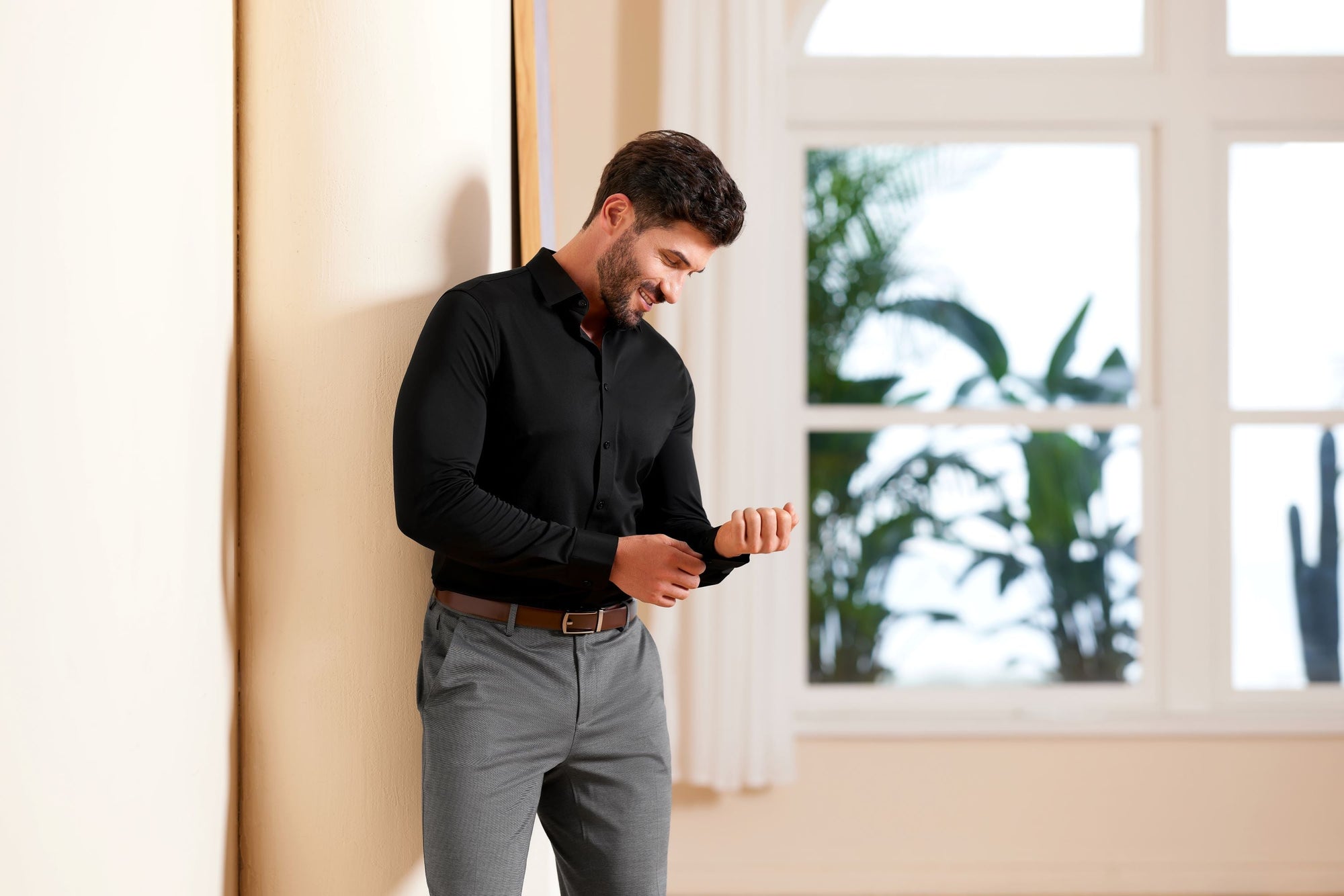Not all dress shirts are created equal. Some are built for the boardroom. Others are better suited for a night out or a relaxed weekend brunch.
Understanding the difference between a formal and an informal dress shirt can make or break your look — especially if you're aiming to dress sharp without overdoing it (or worse, showing up underdressed). The tricky part? The line between formal and informal isn’t always obvious. It’s less about labels and more about the details.
From fabric choices to collar styles, there are specific design cues that shift a shirt into one category or the other. Knowing how to spot them is key to building a wardrobe that works in any setting.
Let’s break it down.
What Actually Defines “Formal” and “Informal” in a Dress Shirt?
This isn’t about tuxedos versus Hawaiian shirts. We're talking about subtle shifts in design that send strong style signals.
A formal dress shirt is typically designed to pair with suits and ties. It’s built with clean lines, structured elements, and neutral tones that say, “I mean business.” On the other hand, informal shirts lean more relaxed. They're softer, often more textured, and sometimes intentionally imperfect (in a good way).
The context matters too. A solid white shirt can look ultra-formal at a wedding, but completely casual when untucked with jeans. It’s not just the shirt — it’s how and where you wear it.
Still, certain design features consistently push a shirt toward one end of the formality scale. That’s where we’re heading next.
Key Design Features That Influence Shirt Formality
When you want to figure out whether a shirt leans formal or informal, you can’t just go by the brand or the price tag. You’ve got to look at the construction.
Let’s break down the major elements that influence formality, starting with one of the biggest: fabric.
Fabric Type and Texture
Fabric sets the tone before anything else. You can’t slap a casual fabric into a formal setting and expect it to blend in — it’ll stand out, and not in a good way.
Formal dress shirts are typically made from smooth, tightly woven fabrics that hold structure and polish. These include:
-
Poplin (or broadcloth): Crisp, smooth, and lightweight. Great with a suit and tie.
-
Twill: Slightly textured but still refined. The subtle diagonal weave keeps things sharp without being too stiff.
-
High thread-count cotton: Think Egyptian or Supima cotton — luxuriously soft and sleek, ideal for upscale events.
Informal shirts, on the other hand, bring texture and weight into the mix. These fabrics signal relaxation and laid-back style:
-
Oxford cloth: A bit heavier and more rugged. Often has a basketweave texture.
-
Chambray: Similar to denim in appearance but much lighter — great for a smart casual look.
-
Linen: Wrinkles easily but breathes like a dream. Very casual and often seasonal.
In short: the smoother and more polished the fabric, the more formal the shirt.
Color and Pattern
Color and pattern can turn a dress shirt from office-ready to weekend-casual in seconds.
Formal shirts keep it simple:
-
Colors: Solid white, light blue, soft pastels.
-
Patterns: Pinstripes, subtle checks, or microgrids — if any at all.
-
Contrast: Minimal. The goal is cohesion and understatement.
These shirts are designed to pair easily with suits and ties without drawing too much attention.
Informal shirts are where designers start to have fun:
-
Colors: Bold tones, earthy hues, or washed finishes.
-
Patterns: Plaid, gingham, floral, large stripes — you name it.
-
Details: Sometimes you’ll even find contrast buttons or stitching that immediately reads “casual.”
If you’re trying to gauge the shirt’s formality at a glance, busy patterns and bold colors are a strong clue you’re looking at a casual piece.
Collar Style
The collar isn’t just there to frame your tie — it’s one of the quickest indicators of formality.
Formal collars include:
-
Spread collar: Wide, structured, and built for ties. It pairs well with tailored jackets.
-
Cutaway collar: Even more aggressive than a spread — definitely dressy.
-
Wing collar: Reserved for tuxedos and black-tie events. Unless you're wearing a bow tie, skip it.
Informal collars tone things down:
-
Button-down collar: The classic casual choice. Originally for sport shirts, now widely accepted in business-casual settings.
-
Soft point collar: Less structured, no stiff interfacing — meant to be worn without a tie.
-
Band collar or no collar: Stylish, minimalist, and completely informal.
The more rigid and structured the collar, the more formal the vibe. Soft or relaxed collars lean casual, even if the rest of the shirt is buttoned up.
Cuffs and Closures
Cuffs might seem like a minor detail, but they quietly speak volumes about how formal your shirt is meant to be.
Formal shirts typically feature:
-
French cuffs: Designed to be worn with cufflinks. Clean, structured, and undeniably dressy.
-
Double cuffs: A variation of French cuffs, folded back and fastened with links. Adds sophistication.
-
Stiff construction: Cuffs maintain a crisp line and resist bunching under a blazer.
Informal shirts lean into simplicity:
-
Barrel cuffs: Button cuffs with one or two fasteners — easy, no-fuss, and standard for casual wear.
-
Soft cuffs: Less structure, sometimes even a bit rumpled by design.
-
Contrast or decorative buttons: Adds visual flair, but instantly makes the shirt less formal.
If a shirt needs accessories like cufflinks to complete the look, it's meant for a more formal setting. If it buttons and goes, it's probably more laid-back.
Shirt Front and Placket Design
The front of the shirt is more than just a place to hold buttons — it plays a key role in overall tone.
Formal placket options:
-
French placket (no visible stitching): Minimalist and sleek, often found on high-end dress shirts.
-
Covered placket: Buttons are hidden behind a strip of fabric — ultra-clean and commonly used for formalwear.
-
Tuxedo pleats or bibs: Reserved for formal occasions and black-tie events.
Informal shirt fronts:
-
Standard (American) placket: A visible strip of folded fabric with stitching — casual and classic.
-
No placket at all: Often used in casual shirts with band collars or linen fabrics.
-
Western or utility-style plackets: Decorative and distinctly non-formal.
Visible stitching and added detail = more relaxed. Concealed design = formal.
Fit and Silhouette
Fit can make a shirt feel elevated or completely relaxed, regardless of the material.
Formal fits:
-
Slim fit or tailored fit: Clean lines that follow the body. Meant to be tucked in, worn with jackets.
-
Structured drape: Fabric doesn’t billow or hang loose — it holds shape.
-
Tapered waist: Gives a sharp silhouette under a suit or blazer.
Informal fits:
-
Relaxed or regular fit: Built for comfort and mobility.
-
Untucked lengths: Shorter hems, often designed to look good outside the pants.
-
Boxy or oversized shapes: Popular in casual or streetwear-leaning styles.
Fit is where fashion meets function. Clean, precise shapes = formality. Loose, easygoing fits = casual comfort. If you need help with your fit, check out our fit guide.
Presence of a Pocket
Pockets aren’t just about utility — they’re a loud stylistic cue.
Formal shirts:
-
No pocket: The cleanest, most traditional choice.
-
Hidden or minimal pocket (if any): Often flat and unnoticeable, strictly for function.
Informal shirts:
-
Single chest pocket: Common in Oxford and chambray shirts.
-
Double pockets or flap pockets: Push the shirt solidly into casual territory.
-
Contrast stitching or buttoned pockets: More detail, more casual.
If you see a shirt with noticeable pocket work, it’s almost always meant to be worn outside of formal settings.
Buttons and Additional Details
Small features can make a big difference.
Formal shirts:
-
Mother-of-pearl or resin buttons: Higher-end materials with a subtle finish.
-
Matching thread and buttons: Clean, monochromatic, and minimalist.
-
No decorative stitching or branding.
Informal shirts:
-
Plastic or contrast buttons: Sometimes used as design statements.
-
Contrasting thread colors or exposed stitching: Adds personality, but makes the shirt more relaxed.
-
Visible logos or trims: All signs of a casual shirt.
Even the hardware matters — refined and subtle reads as formal, while visual contrast signals informality.
Choosing the Right Shirt Based on Occasion
Context is everything. Choosing the right dress shirt isn’t just about personal taste — it’s about reading the room.
Business or formal settings:
-
Stick to neutral colors, fine fabrics, structured collars and cuffs.
-
Pair with a suit or blazer. Tucked in. No frills.
Smart casual environments:
-
You’ve got flexibility. Button-down collars, subtle patterns, and relaxed fits work.
-
Untucked shirts can be acceptable — especially in stretch fabrics like those from xSuit.
Casual settings:
-
Go bold. Explore colors, patterns, textures, and fun detailing.
-
Comfort and personality win here — linen, chambray, or Oxford are all in play.
Match the shirt to the setting, not just the mirror.
Formal or Informal? A Dress Shirt Can be Either
Dress shirts don’t come with flashing signs that say “formal” or “informal”—but the design tells you everything if you know what to look for.
Fabric, collar type, buttons, cuffs, fit — each of these elements pushes a shirt up or down the formality scale. The trick is understanding the cues and using them to your advantage.
When in doubt, lean on versatility. A well-designed shirt like those from xSuit can blur the lines and flex between formal and informal depending on how you style it.
The key is intention. If your shirt matches the moment — and fits you right — you’re good to go.


